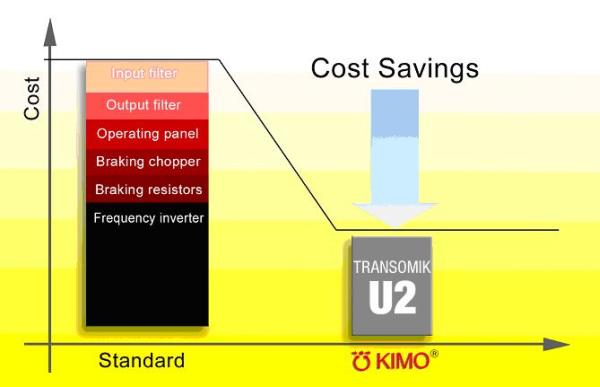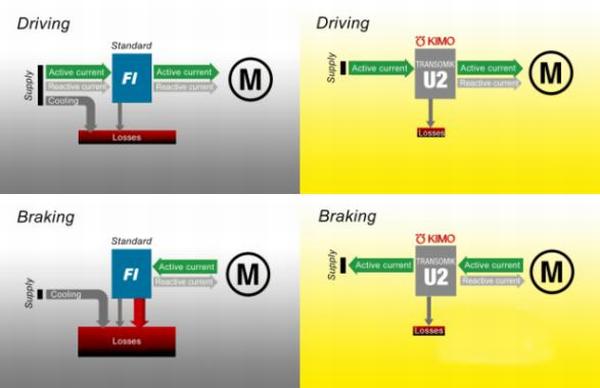About the hidden costs of frequency inverters
Frequency inverters are becoming increasingly important in automation engineering. Many automation tasks that were realised in the past with EC and DC motors as well as a wide range of servo motors are being taken over more and more by three-phase standard motors and frequency inverters. This configuration significantly reduces the costs of the drive components in comparison with servo drives. However, the financial gain seems to obscure possible further cost reductions on drives with frequency inverters.
Studies by the drive specialist KIMO have shown that in applications with frequent drive switching there is even greater potential for savings, both for the manufacturer of the systems and for the organisation operating the systems.
The additional costs for drives with frequency inverters that are not apparent at first glance are described in the following:

Procurement costs

The procurements costs are immediately apparent. For example a 1.1 kW frequency inverter from a supplier has a price that is to be compared with the prices from other suppliers. But be careful! While one supplier includes some or all of the necessary assemblies or units in the price, another supplier only states the price for the frequency inverter. The additional filters necessary on the input (EMC filter) and on the output (dv/dt filter), interface assembly, control console, brake chopper, brake resistors, fans, etc. are not listed initially. However, together they can cost the same or, indeed, even more than the frequency inverter.
Planning costs, design costs
With conventional applications it is only necessary to prepare the electrical circuit diagram. For frequency inverters with analogue and digital control signals via inputs/outputs on the controller the design is then complete. For frequency inverters with data interfaces, as rule, along with the design department it is also necessary to involve the software department to plan, realise and test the programs for the communication. This situation involves corresponding additional effort.
Space costs
Automated systems that are equipped with robots, handling equipment and other reversing machine tools, are often equipped with a large number of drives. As a rule the related frequency inverters are installed in large electrical enclosures. Each frequency inverter and its related equipment require significantly varying amounts of space for mounting in the large electrical enclosure, depending on the manufacturer. This space requirement directly affects the total costs of the electrical enclosure. The supplier who needs the fewest or, even better, no additional units for the frequency inverter has an advantage. In the case of multi-drive installations with the usual additional equipment, one or more additional enclosures become necessary.
A typical 4 kW frequency inverter needs an area on the mounting plate of approx. 6 dm², this figure includes the spacing to the next frequency inverter for heat dissipation. In addition, an area of a similar order of magnitude is required for the input and output filters as well as for the brake resistors. Depending on the requirements for units, 10 to 20 frequency inverters including terminal strips can be mounted on a 1 x 2 m backplate, if the thermal budget permits.
Air-conditioning costs
If the reversing drives for the automation system are switched frequently, then much heat is dissipated by the brake chopper and brake resistors in the electrical enclosure that consideration must be given to these heat losses. Either fewer frequency inverters are fitted in an electrical enclosure or an additional air-conditioning unit with an appropriate rating must be installed to remove the heat. Both measures significantly increase the costs for the drives. Also air-conditioning units cause additional energy costs and require maintenance.
Calculations on typical applications indicate how much energy is dissipated into the electrical enclosure by braking resistors, in addition to the general power losses in the frequency inverter and the power losses in the filters. These data can be requested from KIMO.
The efficiency of a frequency inverter at a rated voltage of 400 V is typically 90 to 95 %. For a 1.1 kW frequency inverter this represents 50 Watt to 100 Watt at rated load. On the input and output filters, power losses are approx. 30 W each, such that in total approx. 110 W to 160 Watt need to be dissipated per frequency inverter in addition to the braking energy. However, if switched frequently the braking energy is dominant. To achieve a high packing density in an enclosure, complex heat management is necessary. In addition to conventional cooling methods, water-cooled mounting plates, heat pipes and forced air-cooling are among other methods used. Another method employed to reduce the space in electrical enclosure is to move the frequency inverter out of the switch cabinet onto the motor, which is already warm.
Special motors with large housings for the frequency inverter and large cooling fins are characteristics of this solution, which involves considerable costs for this combination. In the majority of cases, a dependency on the supplier of the combined motor and frequency inverter then exists. This situation does not generally result in competitive costs.
Installation and commissioning costs
The cable between the frequency inverter to the motor must be screened for interference emission reasons. Here attention must be paid to the correct connection of the screen to obtain the necessary RF properties. The special cable and its complex installation and the special connections must be included in the additional costs for the complete drive.
During the commissioning of digital frequency inverters a series of parameters must be entered and tested for correctness, an activity that, along with the specialist knowledge on the part of the engineer, also costs time. It is also often necessary to rectify initial data transmission problems with the serial fieldbus.
It is easier to commission frequency inverters that communicate with the system’s control electronics using analogue and discrete digital inputs/outputs. In case of a fault the analysis can be undertaken quickly with very simple instruments and without the need for software skills. The need for an additional, unplanned, trip by a software specialist can rapidly result in the drive costs overshooting the budget.
Maintenance costs
Maintenance effort is rarely mentioned for frequency inverters. In the short-term this assessment is also correct. However, in the long-term a typical frequency inverter is subject to limited life expectancy at least with the weakest part the electrolytic capacitors in the link circuit.
The working life reduces significantly with increasing ambient temperature. With continuous operation and an operating temperature of typically 90°C at the capacitor inside the frequency inverter, a working life of only 3 to 5 years can be expected depending on the quality of the electrolytic capacitor. The reducing capacitance results in a performance reduction or the complete failure of the frequency inverter. Repair is in the majority of cases uneconomical, particularly in the lower power range. Once the warranty has expired it is then necessary to purchase and install a new frequency inverter.
Energy costs
The active power for accelerating and driving the machine tool must be supplied by all frequency inverters. In addition, depending on the efficiency of the frequency inverter used, varying power losses occur that must also be paid for.

These costs also include the costs for the reactive current or reactive current compensation for a cos φ less than 1. Furthermore, there are costs for the power losses in the additional units and for the general power losses in the frequency inverter. Last but not least, there are the costs for cooling the electrical enclosure by the air-conditioning units, which are particularly high if the brake resistors represent a large source of heat with frequent switching.
The KIMO U2 series frequency inverters
The analysis on the total costs of drives with frequency inverters at the same time formed a challenging task for the development engineers at the drive specialist KIMO. As a result the U2 series is now currently available with ratings from 4 … 200 kW and with surprising new technical solutions to the problem areas described. A particular advantage worthy of mention is that the hidden costs stated are largely or completely removed.
The highlights of the U2 series with its savings in the problem areas listed above are described summarized in the following.
Purchase cost
Complete frequency inverter. No additional filters necessary on the input or output. No brake resistors or brake chopper necessary.
Planning costs, design costs
Control preferably via standard analogue signals and digital inputs/outputs.
Space costs
Due to the lack of a need for additional units, less area is required. Due to the lack of a need for brake resistors, which would generate heat, several frequency inverters can be installed densely packed in electrical enclosures or they can be installed separately in small housings with a high ingress protection.
Air-conditioning costs
The braking energy is beneficially recovered and fed back to the electrical supply. It does not heat the electrical enclosure, resulting in no additional costs for air-conditioning.
Installation and commissioning costs
Screened cables to the motor are not necessary.
Maintenance costs
No electrolytic capacitor for the link circuit voltage results in long service life of the frequency inverter.
Energy costs
No reactive current costs due to cos φ ≈ 1. Lower or no additional cooling effort, not least because brake resistors are not required and the braking energy is beneficially recovered and fed back to the mains.
As logical as these answers to the hidden costs for the frequency inverter may be, as additional tasks for the cost-neutral implementation of highly dynamic drives they represented a major challenge even for the developers at KIMO who are very experienced in the area of electrical drives and modern power electronics.
The rigorous and uncompromising solutions started where the largest, customer benefit exists. A complex implementation with even more parameters and control functions that would require more time with additional familiarisation by the user has been consciously avoided.
The new U2 series from KIMO represents concentration on the essential for the practical user and on the complete drive costs; this series has further remarkable advantages for the user:

- Switchable without delay on the input and output side
- Wide range of AC and DC input voltage
- Suitable for the use of residual current circuit breakers
- Almost sinusoidal input current
- Low mains harmonics / compliance with the regulations in accordance with EN 61000-3-12
- Low bearing currents
- No short circuit on moment change or rectifier shoot through as with DC drives
- Excellent smooth running properties even at very low speed
- Available in housings with ingress protection up to IP 65 for decentralised
drives.


